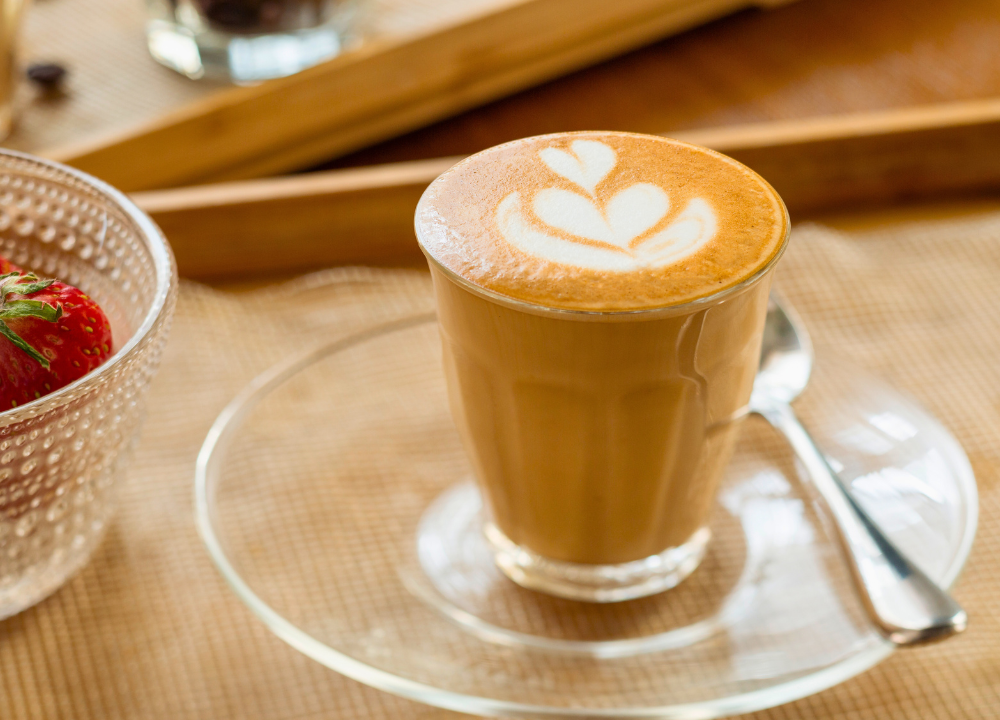This guide will break down the caffeine content of lattes by size and type. Whether you prefer a small, medium, or large latte, knowing the caffeine levels helps you make informed choices. Let’s dive into the details and find out what to expect in your cup!
Do Lattes Contain Caffeine? Understanding The Basics
Lattes are popular drinks made with espresso and steamed milk. But do lattes contain caffeine? The answer is yes. Lattes have caffeine, primarily from the espresso used to make them. Knowing the caffeine content can help you enjoy your latte without the jitters.
What Defines A Latte?
A latte is a creamy coffee drink that combines espresso with steamed milk. The balance of these two ingredients creates a smooth taste. Here are some key characteristics of a latte:
- Made with espresso and steamed milk.
- Typically topped with a small amount of foam.
- Can be flavored with syrups or spices.
The standard latte uses one or two shots of espresso. The espresso gives the drink its caffeine kick. The steamed milk adds a rich, creamy texture. This combination makes lattes different from other milk-based coffee drinks, like cappuccinos.
Here’s a quick comparison of lattes and other drinks:
| Drink Type | Espresso Shots | Steamed Milk | Foam |
|---|---|---|---|
| Latte | 1-2 | More | Little |
| Cappuccino | 1-2 | Less | More |
Most coffee shops serve lattes with one or two shots. Some may use different espresso sizes or roasts, affecting the overall caffeine content.
Espresso: The Caffeine Source In Lattes
Espresso is the heart of a latte. It is a concentrated coffee made by forcing hot water through finely-ground coffee beans. Caffeine value can change based on several factors:
- Differences in espresso roast affect caffeine levels.
- Light roasts may have slightly more caffeine than dark roasts.
- The brewing method can impact extraction and flavor.
Knowing the caffeine levels can help you choose the right drink. Enjoy your latte and savor every sip!

Caffeine Content By Latte Size: 12 Oz, 16 Oz, And 20 Oz
Caffeine plays a major role in our daily coffee rituals. A latte combines espresso with steamed milk, making it a popular choice. The caffeine content varies with the size of the latte. Let’s break it down by size: 12 oz, 16 oz, and 20 oz.
Small, Medium, And Large: How Much Caffeine?
Latte sizes affect caffeine levels significantly. Here’s a simple breakdown:
| Size | Caffeine Content | Espresso Shots |
|---|---|---|
| 12 oz latte | 63 mg caffeine | 1 shot |
| 16 oz latte | 126 mg caffeine | 2 shots |
| 20 oz latte | 189 mg caffeine | 3 shots |
Choosing a smaller size means less caffeine. A 12 oz latte is perfect for a light boost. A 16 oz latte offers more energy. A 20 oz latte gives you a stronger kick. Consider your caffeine needs before ordering.
Customization: How To Adjust Caffeine Levels
Many coffee lovers enjoy personalizing their drinks. Adjusting caffeine levels is simple. Here are some options:
- Adding an extra shot: This gives your latte a stronger kick. For example, a 12 oz latte can become a 16 oz with an added shot.
- Decaf espresso: This is a great alternative. Use decaf shots for a milder drink.
- Choosing different espresso blends: Different blends have varied caffeine content. Experiment to find your favorite.
Decide how much caffeine you want. If you need a boost, go for more shots. If you want less, stick to decaf or a smaller size. Customizing your latte makes it unique to you.
Does Milk Affect Caffeine Absorption?
Understanding this can help you enjoy your coffee better. Milk is a common addition to lattes, but its role in caffeine digestion might surprise you.
The Role Of Milk In Latte Digestion
Milk plays a significant role in how your body digests and absorbs caffeine. When you add milk to your latte, it can change how quickly caffeine enters your bloodstream. Here are some key points:
- Does milk slow down caffeine absorption? Yes, milk may slow down the absorption of caffeine. This is due to the fat and proteins in milk.
- How milk impacts perceived coffee strength: The creamy texture of milk can make the coffee taste smoother. This might lead you to think the caffeine is less strong.
- Milk can also provide other nutrients, which may affect how your body processes caffeine.
Here’s a quick overview of how caffeine absorption differs in lattes and black coffee:
| Drink Type | Caffeine Absorption Speed | Taste Profile |
|---|---|---|
| Latte | Slower | Smooth and Creamy |
| Black Coffee | Faster | Bitter and Bold |
In summary, milk can influence how quickly caffeine enters your system. This effect may impact your overall energy levels.
Latte Vs. Black Coffee: Which Keeps You Awake Longer?
When comparing lattes and black coffee, many wonder which one keeps you awake longer. Several factors come into play:
- Comparing caffeine release in lattes vs. black coffee: Black coffee usually releases caffeine faster. Lattes, with their milk content, slow this process down.
- How sugar and milk influence energy levels: Adding sugar and milk to your latte can create a quick energy spike. However, the crash may come sooner.
Here’s a quick comparison of both drinks:
| Feature | Latte | Black Coffee |
|---|---|---|
| Caffeine Release Speed | Slow | Fast |
| Energy Duration | Shorter | Longer |
| Perceived Strength | Weaker | Stronger |
In the end, black coffee may keep you awake longer than a latte. The slower caffeine absorption in lattes may lead to a quicker energy drop.

